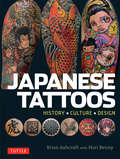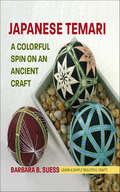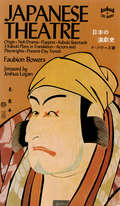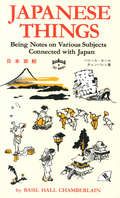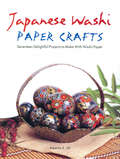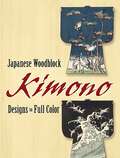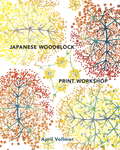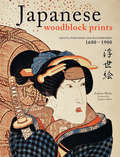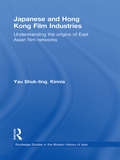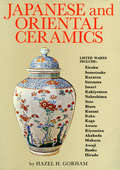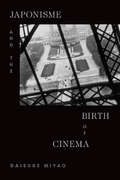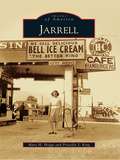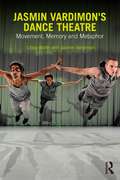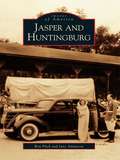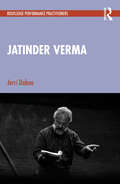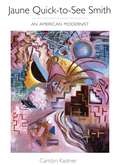- Table View
- List View
Japanese Tattoos: History * Culture * Design
by Brian Ashcraft Hori BennyThinking of getting a Japanese-style tattoo? Want to avoid a permanent mistake? Japanese Tattoos is an insider's look at the world of Japanese irezumi (tattoos).Japanese Tattoos explains the imagery featured in Japanese tattoos so that readers can avoid getting ink they don't understand or, worse, that they'll regret. This photo-heavy book will also trace the history of Japanese tattooing, putting the iconography and kanji symbols in their proper context so readers will be better informed as to what they mean and have a deeper understanding of irezumi. Tattoos featured will range from traditional tebori (hand-poked) and kanji tattoos to anime-inspired and modern works-as well as everything in between. For the first time, Japanese tattooing will be put together in a visually attractive, informative, and authoritative way.Along with the 350+ photos of tattoos, Japanese Tattoos will also feature interviews with Japanese tattoo artists on a variety of topics. What's more, there will be interviews with clients, who are typically overlooked in similar books, allowing them to discuss what their Japanese tattoos mean to them. Those who read this informative tattoo guide will be more knowledgeable about Japanese tattoos.
Japanese Temari: A Colorful Spin on an Ancient Craft
by Barbara B. SuessWith little more than a needle and colorful embroidery threads, Barbara Suess shows how to make beautiful Japanese temari—a folk craft dating back to the to the 12th century. Crafted from the same silk threads used to weave elegant kimonos, temari balls evolved from playthings for children to an exquisite art form that delights all ages. Traditional temari incorporates centuries-old beloved patterns embroidered onto a simple handball. In Japanese Temari, Barbara Suess shares the secrets of making temari balls passed down through generations. Showcased in beautiful color photographs are 24 designs, starting with a simple pattern that can be completed in an hour or less. For every design, color drawings show exactly what to do. Each design introduces a new level of skill, allowing you to build your temari repertoire as you work through the book. Made as gifts or as elegant home decorations, every temari completed will add light and delight to any decor. Suess has thoughtfully included inspirational watercolor drawings and haiku poetry that invite you further inside Japan’s unique artistic traditions. Japanese Temari features: - 24 beautifully embroidered temari designs - Complete, step-by-step directions and easy- to-follow color drawings - A “ball prep” primer - At-a-glance stitch guides for right and left-handed stitchers - An illustrated glossary, plus a guide for temari teachers Barbara Suess’s Japanese Temari will give you hours of pleasure as you create objects of delight to have and to give!
Japanese Theatre
by Joshua Logan Faubion BowersJapanese Theatre, by Faubion Bowers, presents a full historical account for Westerners of the theatre arts that have flourished for centuries in Japan. "This book," say Mr. Bowers, "is a survey of what theatre arts exist there today and how they arose. Because Kabuki is the dominant type of drama in Japan today, and has been for three centuries, I have given most attention to it."This book, with its many excellent photographs, is a permanent addition to the West's knowledge of the exotic, exciting theatre of Japan and its tradition of great acting.
Japanese Things
by Basil Hall ChamberlainArmchair travelers beware!Japanese Things will lure you out of your cozy, comfy home and chair to an unusual country with bewitching manners and customs-and once you have succumbed to its spell you will never be the same. Here in one neat package you will meet the flavor, charm, and piquancy of old Japan-a revised reprint of one of the indispensable books on Japan, by the late Prof. Basil Hall Chamberlain,eminent British scholar who in the latter part of the 19th century "taught Japanese and Japan to the Japanese." Many books in one, this monumental compilation contains such diversified subjects as Art and Abacus; Botany and Buddhism; Charms and Cherry Blossoms; Daimyos and Divination; Fairy Tales and Flowers; Gardens and Government; History and Hara-kiri; Law and Language; Marriage and Music; Poetry and Pottery; Shinto and Singing Girls (Geisha); Tea and Theater, and Writing and Wood Engraving. In this long-awaited reprint, in which the title has been changed from Things Japanese, the reader will encounter exquisite objects of daily Japanese life, the gardens and cultures of the fields, the harmony and balance in the fundamentals of day-by-day existence.
Japanese Things
by Basil Hall ChamberlainArmchair travelers beware!Japanese Things will lure you out of your cozy, comfy home and chair to an unusual country with bewitching manners and customs-and once you have succumbed to its spell you will never be the same. Here in one neat package you will meet the flavor, charm, and piquancy of old Japan-a revised reprint of one of the indispensable books on Japan, by the late Prof. Basil Hall Chamberlain,eminent British scholar who in the latter part of the 19th century "taught Japanese and Japan to the Japanese." Many books in one, this monumental compilation contains such diversified subjects as Art and Abacus; Botany and Buddhism; Charms and Cherry Blossoms; Daimyos and Divination; Fairy Tales and Flowers; Gardens and Government; History and Hara-kiri; Law and Language; Marriage and Music; Poetry and Pottery; Shinto and Singing Girls (Geisha); Tea and Theater, and Writing and Wood Engraving. In this long-awaited reprint, in which the title has been changed from Things Japanese, the reader will encounter exquisite objects of daily Japanese life, the gardens and cultures of the fields, the harmony and balance in the fundamentals of day-by-day existence.
Japanese Things
by Basil Hall ChamberlainArmchair travelers beware!Japanese Things will lure you out of your cozy, comfy home and chair to an unusual country with bewitching manners and customs-and once you have succumbed to its spell you will never be the same. Here in one neat package you will meet the flavor, charm, and piquancy of old Japan-a revised reprint of one of the indispensable books on Japan, by the late Prof. Basil Hall Chamberlain,eminent British scholar who in the latter part of the 19th century "taught Japanese and Japan to the Japanese." Many books in one, this monumental compilation contains such diversified subjects as Art and Abacus; Botany and Buddhism; Charms and Cherry Blossoms; Daimyos and Divination; Fairy Tales and Flowers; Gardens and Government; History and Hara-kiri; Law and Language; Marriage and Music; Poetry and Pottery; Shinto and Singing Girls (Geisha); Tea and Theater, and Writing and Wood Engraving. In this long-awaited reprint, in which the title has been changed from Things Japanese, the reader will encounter exquisite objects of daily Japanese life, the gardens and cultures of the fields, the harmony and balance in the fundamentals of day-by-day existence.
Japanese Washi Paper Crafts
by Robertta A. UhlIn Japan, paper and paper crafts are held in popular esteem. The originators of origami, the art of paper-folding, and kirigami, the art of paper-cutting, the Japanese also make their own paper, called washi. A colorful printed paper, washi is used to decorate everything from boxes to dolls. Noted for its strength, durability and flexibility, washi paper is available in a rich array of colors, textures, weights and patterns.Japanese Washi Paper Crafts is a selection of seventeen designs for decorating commonly available objects, such as milk cartons, boxes and eggs, which can be used in home decor, as gifts, or for special occasions. Every project is shown with clear, step-by-step diagrams. Color photographs show completed projects, as well as imaginative ways for displaying the finished crafts.
Japanese Washi Paper Crafts
by Robertta A. UhlIn Japan, paper and paper crafts are held in popular esteem. The originators of origami, the art of paper-folding, and kirigami, the art of paper-cutting, the Japanese also make their own paper, called washi. A colorful printed paper, washi is used to decorate everything from boxes to dolls. Noted for its strength, durability and flexibility, washi paper is available in a rich array of colors, textures, weights and patterns.Japanese Washi Paper Crafts is a selection of seventeen designs for decorating commonly available objects, such as milk cartons, boxes and eggs, which can be used in home decor, as gifts, or for special occasions. Every project is shown with clear, step-by-step diagrams. Color photographs show completed projects, as well as imaginative ways for displaying the finished crafts.
Japanese Woodblock Flower Prints
by Tanigami KônanExceptionally drawn in a realistic fashion and awash in spectacularly rich colors, this one-of-a-kind art book -- masterfully reprinted from a rare and costly edition -- combines the perennial appeal of flowers with the art of Japanese woodblock prints.Nothing expresses the richness and vigor of life like blooming flowers. A stunning showcase of 120 full-color plates, this specially chosen collection features beautiful Eastern and Western botanicals that will delight flower lovers, artists, designers, and devotees of fine art. Admire such familiar and unusual blossoms as the poppy, rose, anemone, cyclamen, delphinium, water lily, lupine, passion flower, allamanda, phlox, dahlia, petunia, tulip, freesia, pansy, begonia, and many more beautiful blooms!Tanigami Kônan (1879-1928) was a genius at the art of woodblock creation and color gradation, and he is still celebrated as one of the finest artists of this highly specialized technique. Captions and a complete index are included in this distinct keepsake edition.
Japanese Woodblock Kimono Designs in Full Color
by DoverThe delicate beauty of the kimono and its appealing designs embody Japan's ancient and venerable tradition of textile arts. This unusual design treasury recaptures the graceful art of the kimono in all its subtle elegance, with authentic designs from a nineteenth-century source.Reproduced directly from a rare and costly original portfolio, these luminous designs include allover patterns, nature scenes, magnificent floral sprays, and other finely detailed motifs. Sixty-two lavish full-color illustrations offer a vibrant resource of inspiration and browsing pleasure to devotees of fashion, art, and Asian culture.
Japanese Woodblock Print Workshop
by April VollmerAn inspirational how-to course on Japanese woodblock printing's history and techniques, with guidance on materials and studio practices, step-by-step demonstrations, and examples of finished works by modern masters of the medium as well as historic pieces. A Modern Guide to the Ancient Art of mokuhanga An increasingly popular yet age-old art form, Japanese woodblock printing (mokuhanga) is embraced for its non-toxic character, use of handmade materials, and easy integration with other printmaking techniques. In this comprehensive guide, artist and printmaker April Vollmer--one of the best known mokuhanga practitioners and instructors in the West--combines her deep knowledge of this historic printmaking practice with expert step-by-step instruction, guidance on materials and studio practices, and a diverse collection of prints by leading contemporary artists. At once practical and inspirational, this handbook is as useful to serious printmakers and artists as it is to creative people drawn to Japanese history and aesthetics.From the Hardcover edition.
Japanese Woodblock Prints
by Stephen Addiss Andreas MarksJapanese woodblock prints, or ukiyo-e, are the most recognizable Japanese art form. Their massive popularity has spread from Japan to be embraced by a worldwide audience. Covering the period from the beginning of the Japanese woodblock print in the 1680s until the year 1900, Japanese Woodblock Prints provides a detailed survey of all the major artists, along with the images on which their fame rests.Unlike previous examinations of this art form, Japanese Woodblock Prints includes detailed histories of the publishers of woodblock prints--who were often the driving force determining which prints, and therefore which artists, would make it into mass circulation for a chance at critical and popular success. Invaluable as a guide for ukiyo-e enthusiasts looking for detailed information about their favorite artists and prints, it is also an ideal introduction for newcomers to the world of the woodblock print. This lavishly illustrated book will be a valued addition to the libraries of scholars, as well as the general art enthusiast.
Japanese Woodblock Prints
by Stephen Addiss Andreas MarksJapanese woodblock prints, or ukiyo-e, are the most recognizable Japanese art form. Their massive popularity has spread from Japan to be embraced by a worldwide audience. Covering the period from the beginning of the Japanese woodblock print in the 1680s until the year 1900, Japanese Woodblock Prints provides a detailed survey of all the major artists, along with the images on which their fame rests.Unlike previous examinations of this art form, Japanese Woodblock Prints includes detailed histories of the publishers of woodblock prints--who were often the driving force determining which prints, and therefore which artists, would make it into mass circulation for a chance at critical and popular success. Invaluable as a guide for ukiyo-e enthusiasts looking for detailed information about their favorite artists and prints, it is also an ideal introduction for newcomers to the world of the woodblock print. This lavishly illustrated book will be a valued addition to the libraries of scholars, as well as the general art enthusiast.
Japanese Woodblock Prints in Miniature: The Genre of Surimono
by Kurt MeissnerThis beautifully illustrated book, a collector's item, is based on the author's private collection of more than sixty years. It is a unique introduction to the background and aesthetic appreciation of the rare and elegant art form. Included in the pages are notes on technique, terminology, surimono collecting and commissioning, as well as biographies of known surimono artists, and a detailed list of surimono catalogs and exhibitions. The text is supplemented by 33 color plates, Index Glossary, and Annotated Bibliography.
Japanese Woodblock Prints in Miniature: The Genre of Surimono
by Kurt MeissnerThis beautifully illustrated book, a collector's item, is based on the author's private collection of more than sixty years. It is a unique introduction to the background and aesthetic appreciation of the rare and elegant art form. Included in the pages are notes on technique, terminology, surimono collecting and commissioning, as well as biographies of known surimono artists, and a detailed list of surimono catalogs and exhibitions. The text is supplemented by 33 color plates, Index Glossary, and Annotated Bibliography.
Japanese and Hong Kong Film Industries: Understanding the Origins of East Asian Film Networks (Routledge Studies in the Modern History of Asia)
by Shuk-ting, Kinnia YauDrawing on first-hand materials collected from the Chinese and Japanese literature as well as interviews with more than twenty filmmakers and scholars Kinnia Shuk-ting Yau provides a solid historical account of the complex interactions between Japanese and Hong Kong film industries from the 1930s to 1970s. The author describes in detail how Japan’s efforts during the 1930s and 1940s to produce a "Greater East Asian cinema" led to many different kinds of collaborations between the filmmakers from China, Hong Kong and Japan, and how such development had laid the foundation for more exchanges between the cinemas in the post-war period. The period covered by the book is the least understood period of the East Asian film history. Filling the gaps surrounding one of the most important but least understood periods of Asian film history this books discusses facts and resources once obscured by controversial issues related to wartime affairs with new insights and perspectives. This book is an invaluable source of information for understanding how the current East Asian film networks came into existence by looking beyond conventional single-case studies and adopting a transnational perspective in tracing the connections between different film industries.
Japanese and Oriental Ceramics
by Hazel H. GorhanJapanese and Oriental Ceramics was first published in print form by Tuttle Publishing in 1971.This comprehensive and profusely illustrated work tells how to distinguish Japanese porcelains from Chinese, and how to recognize modern reproductions of genuine old wares. It is completely indexed, contains a lengthy bibliography, and lists Chinese dates important in any discussion of Oriental ceramics.Crammed with information on the history, esthetics, and technical aspects of the ceramics of Japan and the Orient, the book is an invaluable guide to scholars, collectors and dealers. It is in fact a work of art in itself.
Japonisme and the Birth of Cinema
by Daisuke MiyaoIn Japonisme and the Birth of Cinema, Daisuke Miyao explores the influence of Japanese art on the development of early cinematic visual style, particularly the actualité films made by the Lumière brothers between 1895 and 1905. Examining nearly 1,500 Lumière films, Miyao contends that more than being documents of everyday life, they provided a medium for experimenting with aesthetic and cinematic styles imported from Japan. Miyao further analyzes the Lumière films produced in Japan as a negotiation between French Orientalism and Japanese aesthetics. The Lumière films, Miyao shows, are best understood within a media ecology of photography, painting, and cinema, all indebted to the compositional principles of Japonisme and the new ideas of kinetic realism it inspired. The Lumière brothers and their cinematographers shared the contemporaneous obsession among Impressionist and Post-Impressionist artists about how to instantly and physically capture the movements of living things in the world. Their engagement with Japonisme, he concludes, constituted a rich and productive two-way conversation between East and West.
Jarrell
by Priscilla S. King Mary H. HodgeIn 1909, real estate developer Orlando D. Jarrell had a vision: He would sell lots near the Bartlett Western Railroad site and name the town Jarrell. When the railroad bypassed the nearby town of Corn Hill and Jarrell's lots began to sell, the residents of Corn Hill--and their houses--moved to the promising, new town. Rock quarries became and are still a mainstay of this area, shipping limestone all over the world. About 200 vintage photographs illustrate the time between 1855 and more recent years, including the monstrous 1997 tornado that put Jarrell into the national spotlight.
Jasmin Vardimon's Dance Theatre: Movement, memory and metaphor
by Jasmin Vardimon Libby WorthJasmin Vardimon’s Dance Theatre offers an unusual, intimate insight into the devising and training processes of a choreographer in the midst of her practice. Libby Worth and Jasmin Vardimon take a collaborative approach to recording and exploring the working processes of Vardimon and her company, chronicling the development of specific productions rather than offering a single choreographic blueprint. Focusing on the techniques, strategies and creative activities necessitated by each project, Worth and Vardimon address: The initial ‘triggers’ which lead to research, expansion, and performance; The social, political and psychological content of Vardimon’s work; The relationship between accessibility of content and complexity of ideas; Drawing on texts to enhance and shape a piece of dance work; The editing process, and its inherent messiness; The contribution of a company’s different voices and viewpoints to the development of a production. Based on extended conversations and interviews, this highly illustrated, full -colour volume is a unique reflection on Jasmin Vardimon’s vibrant, continually developing practice. It is a must-read for students and practitioners of dance and physical theatre.
Jason Priestley: A Memoir
by Jason PriestleyJason Priestley, star of the iconic hit television series Beverly Hills, 90210 and one of the biggest teen idols of the 1990s, chronicles the highs and lows of his life and career in this charming and honest memoir.The hit Fox show Beverly Hills, 90210 became a cultural touchstone of the 1990s and propelled its young cast to mega-stardom, including Jason Priestley, who played honorable Midwestern transplant Brandon Walsh. Yet despite more than twenty years in and out of the limelight, Priestley has carefully maintained his privacy. In this compelling memoir, the actor, director, and race-car aficionado invites us into his private world for the first time.With humor, sincerity, and charm, Priestley offers little-known details about his life and stories of his nine years in America’s most famous zip code. He talks candidly about celebrity, marriage, fatherhood, and his passion for car racing. He does not shy away from the devastating lows—his brief jail sentence for drunk driving and the crash at the Kentucky Speedway that nearly took his life. Priestley shares his innermost thoughts about life as a ’90s icon, and goes beyond the Brandon Walsh squeaky-clean image, revealing the tumultuous events that have shaped him, and where he finds his greatest happiness today.
Jasper and Huntingburg
by Jane Ammeson Ron FlickNestled in the rolling hills of Southern Indiana, Jasper and Huntingburg are quintessential American towns where hard work and dedication to cultural and ethnic preservation contribute to the beauty and prosperity of the area. The strong European roots of these Dubois County towns are evident in soaring churches and the nearby Monastery of the Immaculate Conception. German traditions passed down by immigrants from the Black Forest and Bavaria have earned Jasper the title of the "Nation's Woodworking Capital," while Scotch and Irish heritage are also woven into the fabric of the region. These divergent influences have created architecturally and historically significant towns proud of their past and ready to embrace their future.
Jatinder Verma (Routledge Performance Practitioners)
by Jerri DabooJatinder Verma has been a pioneering figure in the development of British South Asian theatre, and a prominent spokesperson for the importance of increased diversity amongst playwrights, actors, directors, designers, and producers on the mainstream British stage. As co-founder and former Artistic Director of Tara Arts, he developed a new aesthetic style known as 'Binglish' which creates a hybrid dramaturgy of languages, training and performance forms, and styles of acting, and design, that operates to establish a negotiation between cultures which reflects contemporary Britain. Verma is acknowledged as being a leading practitioner and director, as well as writer about theatre and culture, who has transformed the face of theatre in Britain and internationally.This book combines:• a detailed biography giving the social and artistic context of Verma’s work and his work with Tara Arts;• an exploration of Verma’s own writings on ‘Binglish’, including his use of a range of performance forms and philosophies from different cultures, such as the importance of the Natyashastra in his thinking and practice;• a stylistic analysis of his key productions, including Tartuffe, The Merchant of Venice, Macbeth, and the Bollywood pantomimes;• pathways into some of the practical exercises relating to the dramaturgical style of ‘Binglish’ devised by Jatinder Verma.As a first step towards critical understanding, and as an initial exploration before going on to further, primary research, Routledge Performance Practitioners offer unbeatable value for today’s student.
Jaune Quick-to-See Smith: An American Modernist
by Carolyn KastnerThe first full-length critical analysis of the paintings of Jaune Quick-to-See Smith, this book focuses on Smith&’s role as a modernist in addition to her status as a wellknown Native American artist. With close readings of Smith&’s work, Carolyn Kastner shows how Smith simultaneously contributes to and critiques American art and its history.Smith has distinguished herself as a modernist both in her pursuit of abstraction and her expressive technique, but too often her identity as a Native American artist has overshadowed these aspects of her work. Addressing specific themes in Smith&’s career, Kastner situates Smith within specific historical and cultural moments of American art, comparing her work to the abstractions of Kandinsky and Miró, as well as to the pop art of Rauschenberg and Johns. She discusses Smith&’s appropriation of pop culture icons like the Barbie doll, reimagined by the artist as Barbie Plenty Horses. As Kastner considers how Smith constructs each new series of artworks within the artistic, social, and political discourse of its time, she defines her contribution to American modernism and its history. Discussing the ways in which Smith draws upon her cultural heritage—both Native and non-Native—Kastner demonstrates how Smith has expanded the definitions of &“American&” and &“modernist&” art.
Java 2D Graphics
by Jonathan KnudsenJava 2D Graphics describes the 2D API from top to bottom, demonstrating how to set line styles and pattern fills as well as more advanced techniques of image processing and font handling. You'll see how to create and manipulate the three types of graphics objects: shapes, text, and images. Other topics include image data storage, color management, font glyphs, and printing.
